8+ SAMPLE Landscape Estimate
-
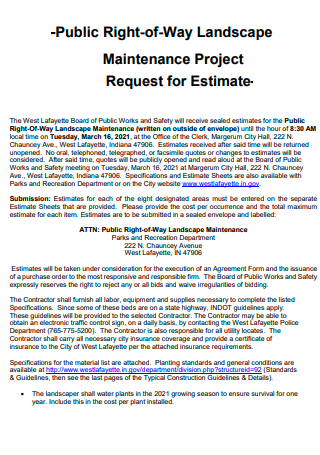
Landscape Maintenance Project Estimate
download now -

Landscape Enhancement Estimate
download now -

Basic Landscape Estimate
download now -
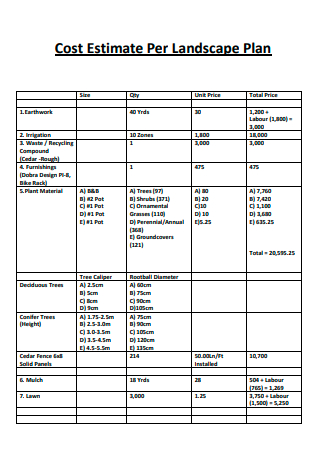
Landscape Plan Cost Estimate
download now -
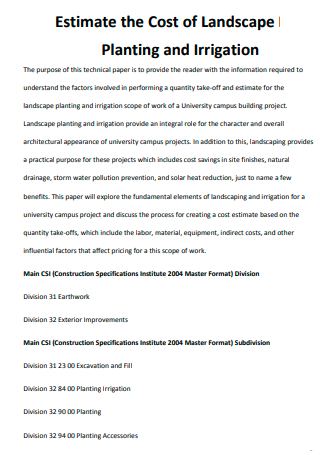
Cost of Landscape Planting and Irrigation Estimate
download now -

Landscape Estimate in PDF
download now -
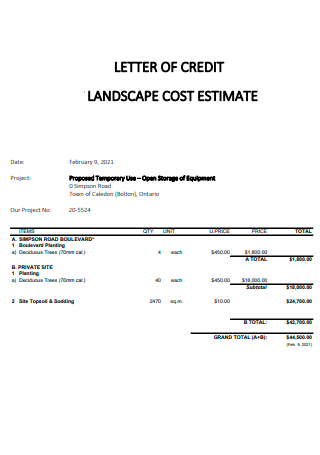
Landscape Cost Estimate
download now -
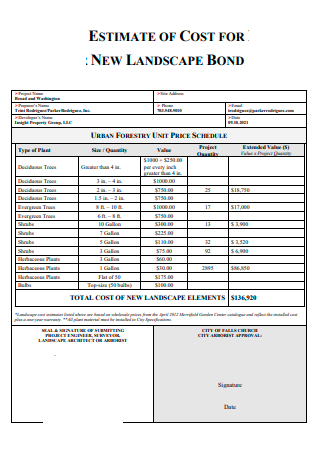
Landscape Bond Estimate
download now -
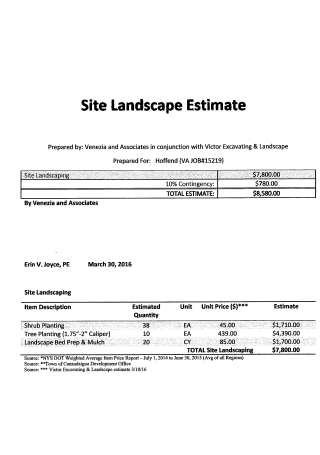
Site Landscape Estimate
download now
FREE Landscape Estimate s to Download
8+ SAMPLE Landscape Estimate
What Is Landscape Estimate?
What Is a Landscape or Landscaping?
What Is a Landscape Estimator?
What Are the Benefits of Landscaping?
Steps to Reach a Landscaping Estimate:
FAQs
How Much Does a Landscaper Charge Per Hour?
Does An Estimate Include More Than Costs and Quantities?
How Does a Contractor Prepare an Estimate?
Estimating landscaping correctly is key to running a profitable business. Statistics show that most contractors only make a profit on three out of every five jobs. They lose money on one and break even on the other. Learning how to accurately bid on landscaping work will make sure you are making a profit on every job you do.
What Is Landscape Estimate?
A quote or landscape estimate is a professional document that states the total cost and the pricing breakdown of certain projects. A landscaping quote will show the average cost of landscaping and will include other details like services provided, client information, terms and conditions, landscaping hourly rate, etc.
Key points to remember when quoting:
- Your company name, logo, and contact information.
- Service description with cost per service
- Mention the quote expiry date as the prices may fluctuate.
- Add a service note to mention if you need a deposit for purchasing specific material or initiating a particular task.
What Is a Landscape or Landscaping?
People have practiced landscaping for centuries. As far back as the ancient Mayans, humans were manipulating the land for both aesthetic and practical reasons. The addition of plants, changes to the existing terrain and the construction of structures are all part of landscaping. Today landscaping refers to the planning, laying out and construction of gardens that enhance the appearance and create useable space for outdoor activities around a home.
Modern landscaping is a process that makes changes to an area of land in one or all of the following three categories:
- Plants – The addition of ornamental, edible, native or other types of landscaping plants.
- Terrain – Changing the shape of the land through grading, backfilling, mounding, terracing, etc.
- Structures – Constructing fences, patio covers, walls, decks, raised planters or other built features.
When it comes to landscaping, the options abound. Some people want a perfectly balanced combination of hardscape (patios) and softscape (plants). Some people want a sustainable landscape design that saves water and creates a natural habitat. While other people want to recreate a certain garden style that they find appealing, such as modern or tropical. Still others want a space complete with an outdoor kitchen, fire pit and swimming pool where they can entertain friends and family. Whatever you desire, make sure you communicate this clearly to the pro you are working with.
The internet is a good place to gather ideas for your own landscaping project. Start by browsing landscaping pictures and take note of what you do and do not like. Next, look at examples of local landscaping projects to determine what works in your area. Finally, research and learn about the specific features you would like to include in your landscape.
What Is a Landscape Estimator?
A landscape estimator is often one of the first professionals on a job site as they work with design plans to create the list of all materials and item quantities required to bring the plan to life. These professionals are responsible for calculating the material costs of the job and creating estimates on the labor and equipment required to build the job. Like many other landscape professionals in this team-oriented industry, estimators usually work with other colleagues – including experienced installation managers and purchasing managers – to arrive at a final job cost to present to the client. In the maintenance business, the landscape estimator may inspect new properties, measuring lawns, beds and hardscapes to help determine the labor and equipment required to maintain the property.
What Are the Benefits of Landscaping?
While most people spend the majority of their time indoors, most of us are still undeniably drawn outside to soak in the sights and sounds of nature. There’s just something about the sunshine, green grass, pretty flowers, sweet fragrances, and animals that make the outdoors relaxing and rejuvenating.
Steps to Reach a Landscaping Estimate:
Here are the best ways to learn Landscape Estimate:
Step 1: Talk to the Client
First things first, talk to the client about what they want. Do this before you start your estimate and ask lots of questions. Make sure you visit the property yourself and measure it. Develop a plan to complete the job and decide what kind of materials, subcontractors and extra labor you may need. Hardscaping will be pricier as you’ll need to build walls, pathways, and so on. Consider the following landscaping factors:
- Client’s desired landscaping style or design (Japanese etc.)
- Features required, like a stone pathway
- Types of plants and materials required
- Location (is it remote?)
- Quality of soil
- Need to remove or add soil
- Sod vs. seeding
- Need to grade or reslope the land
- Current condition of the yard
- Need to get rid of plants or features like a pathway or patio
- Landscaping Network has a comprehensive landscaping prices list for specific services, like installing a patio or fence.
Step 2: Estimate Overhead Costs
You must take overhead costs into account to properly price your landscaping jobs. Vans, gas, advertising, office rent, equipment repair and maintenance, cell phones, tools, uniforms, accountants and insurance all cost money and you need to recoup them. Most small businesses underestimate how much they actually spend on overhead. You need an accurate number. If you don’t, chances are you won’t be making profit even after you add a markup. It is better not to ballpark it. Add up your weekly overhead costs and divide that cost between the number of hours you work per week on average. Add that amount to the job cost, based on the estimated number of hours you think the project’s going to take.
Step 3: Estimate Materials Costs
You established a project plan in step one, so now, it is easy to figure out materials costs. You should already know exactly what materials you’re including in the job. Calculate how much you will need based on your measurements of the site. Now you have your total materials cost. Add it to total project costs.
Step 4: Estimate Subcontractor Costs
This part’s simple. Send your trusted subcontractor(s) your project specifications and ask them to quote you a price. Add that price to your total job cost.
Step 5: Estimate Labor Costs
Add your hourly rate to the equation, if you are the one doing the job. That way you’ll always get paid. Otherwise, estimate labor costs for your other employees. You also want to add payroll tax costs (FICA) on top of your labor costs. About 18 percent extra is a good idea.
Step 6: Add Your Markup
Overhead costs (see step two) are not part of your markup. Your markup needs to be applied on top of the total cost to you to perform the job. This way you’ll always be making a profit. Charge at least a 15 to 20 percent markup on residential landscaping jobs and 10 to 15 percent on commercial landscaping jobs. Commercial landscaping is more competitive and you need to price lower to survive. Maintenance landscaping can charge a 10 to 12 percent markup for both residential and commercial work.
Step 7: Calculate the Total Price
Add up all your landscaping costs listed in the above steps plus your markup to find the price you’ll quote the customer for their landscaping job. Remember to add sales tax to the estimate, if your state requires it. Some states, like Nevada, do not require service-based businesses like landscaping to charge their customer’s sales tax.
FAQs
How Much Does a Landscaper Charge Per Hour?
A landscaper charges $45 to $75 per hour. The price range is the same for new landscaping and landscaping maintenance.
Does An Estimate Include More Than Costs and Quantities?
Yes. Estimates also provide descriptions of the work to be done. For instance, an estimate for a concrete patio will include the area, cost per square foot and total estimated cost of the concrete, but it will also briefly describe the base beneath the concrete, the depth of concrete to be poured, the placement of rebar within the concrete, the surface finish of the concrete, and the strength standard to be met by the finished patio.
How Does a Contractor Prepare an Estimate?
Contractors begin a project with a visit to the site and a review of the proposed design. They then prepare and share an estimate with the client, using their professional expertise to determine material costs and labor hours.
The budget for your landscaping depends on how you envision your outdoor space. Through your landscaping design, you can make your garden more aesthetically appealing. Keep in mind that good landscaping is much more than just installing trees, shrubs, and a lawn, or creating a patio, installing a gazebo, and front walkways. It’s how a homeowner conveys that they are house proud and love to showcase their home in the best light.
Your landscaping estimate is dependent on the elements you intend to introduce. Are you a keen gardener who likes to keep things simple with flower beds or a homeowner who likes a mix of both softscape and hardscape designs? Your choices will make all the difference in costs.
So, if you are planning to get a beautiful landscape for your home, you will want to be on top of the renovation process. And, a landscaping estimate will give you that edge.
